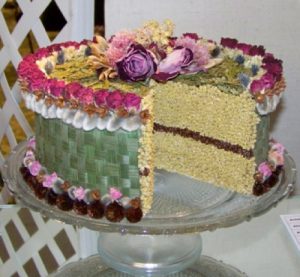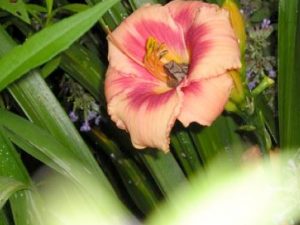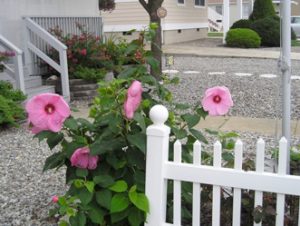Maine Home Garden News — June 2012
- June is the month to . . .
- Time To Start an Asparagus Bed!
- Edible Flowers: Pretty in Your Garden and a Culinary Delight
By Tori Jackson, Extension Educator, University of Maine Cooperative Extension, Androscoggin & Sagadahoc Counties, tori.jackson@maine.edu.
- Identify white grubs you may have in your lawn and apply preventive treatment, if necessary. It is too late to treat for the grubs you have now, but you may be able to impact the next generation. For assistance in identifying white grubs, contact the Insect and Plant Disease Diagnostic Lab in Orono. Be sure to read and follow the label of any pesticide you use. The label is the law!
- Enroll in Maine Harvest for Hunger to help provide fresh, local produce to Maine’s food insecure. You can help us reach our goal of 300,000 pounds in 2012. Information and enrollment are available online. These fact sheets on Food for ME: Citizen Action for Community Food Recovery will give you some ideas for community gardens, gleaning, and other ways you can help.
- Stake your tomato plants to ensure good air flow, reduce diseases, and improve fruit development. For a quick how-to, check out Vegetable Specialist Mark Hutton demonstrating some best practices (YouTube). If you prefer tomato cages, he can give you some tips for that as well.
- Consider container gardening! If you are short on space, time or both, container gardens can be a great way to enjoy fresh produce on your deck or patio all summer long. Extension Educator, Barbara Murphy can show you how.
- Think about garden safety. From choosing a site for your garden to harvesting and washing your produce, plan ahead to ensure the safety of the foods you grow. For more tips on food safety, visit our Food & Health website.
- Visit a local strawberry farm to pick your own delicious summer fruit. You can find a farm near you at the Maine Department of Agriculture’s website. When you get home, enjoy your strawberries fresh or preserve them by freezing or making jam to enjoy them year-round.
- Get ahead of garden pests by mulching where you can to reduce weed pressure and regularly scouting your plants for insects. Consider Integrated Pest Management (IPM) when you have a pest management issue.
- Get in the habit of protecting yourself from the sun. Simple steps like daily sunscreen application and wearing a hat when working in the sun can go a long way to preventing skin cancer.
- Introduce a child in your life to the joys of gardening! Fresh air, exercise, and the satisfaction of a job well done are some of the benefits you get from gardening. When learned at a young age, gardening can be a hobby and skill a child takes with them for the rest of their life. Check out our Kids Can Grow program!
Time To Start an Asparagus Bed!
By David Handley, Extension Professor and Mark Hutton, Extension Vegetable Specialist, Highmoor Farm, Monmouth, ME, david.handley@maine.edu, mark.hutton@maine.edu.
Asparagus is often the first vegetable that we can harvest from the garden in the spring, and the sight of those tender spears emerging from the soil fills a gardener with hopeful anticipation for the coming season.
An asparagus planting is usually established from fleshy crowns bought from a nursery supplier or local garden center. Plants can also be started from seed, which should be planted into peat pots and started indoors about six weeks prior to moving outdoors. It is important to select varieties that are disease resistant and will perform well under Maine’s challenging climate. Varieties we presently recommend include Mary Washington Improved, Jersey King, Jersey Knight, Guelph Millennium, and for those wanting spears with a unique color, Purple Passion.
The site for an asparagus planting must have a well drained soil, because plants in wet soils will succumb to root rot problems. A soil test should be carried out well before planting and any needed amendments should be worked in during the fall or spring prior to planting. Perennial weeds such as quack grass must be eliminated prior to planting, or they will quickly overcome the crop. Asparagus should be planted on the west or north edge of a garden to prevent the ferns from shading other crops and interfering with tillage of the rest the garden. Plant asparagus in the spring after the danger of hard frost has past. How much should you plant? Figure that each crown should produce about ½ pound of spears per year once fully established.
To plant dormant crowns, dig a furrow two to three inches wide and about four to six inches deep. Phosphorus can be helpful in plant establishment. If your soil tends to be low in phosphorus, apply about two pounds of super phosphate (0-20-0) per 50 feet of row along the bottom of the furrow (bone meal can also be used, but it tends to attract skunks). Space the crowns about 18 inches apart at the bottom of the furrow. If planting more than one row, space them at least four feet apart to allow the ferns plenty of growing space. After planting, fill the furrow back up to the original soil level, but do not compact or press the soil over the buried crowns, as this may damage the buds and will delay spear emergence. Keep the soil moist. You should start to see spears emerging in one to two weeks. Do not harvest the spears during the planting year. The spears will elongate and form “ferns,” which will support and promote the growth of the roots. The plants can be mulched lightly during the growing season to help reduce weed pressure with wood shavings, pine needles or the like.
The ferns will die off in the fall and should be mowed off either late in the fall or early in the spring, prior to the emergence of new spears. Waiting until spring may improve winter survival. During the second year spears may be harvested as they emerge over a two to three week period. Snap the shoots off when they are seven to nine inches high and before the tips start to loosen. The bed should be harvested every three to four days. After three weeks stop harvesting and allow the shoots to develop ferns to build up the plants for next year. Fertilizer should be applied after the last harvest. About ½ pound of ammonium nitrate or 1 ½ pounds of 10-10-10 should be applied over 50 feet of row. An application of compost over the plants can also be used as a fertilizer. Check the product container to determine its nutrient levels.
Late frost or cutworms can cause the spears to “crook” after they emerge, and asparagus beetles and their larvae may be found feeding on the ferns during the season. In the latter case, handpicking may provide an effective means of control on a small planting, but insecticides may be warranted on larger plantings. There are both organic and synthetic insecticide options available, but be sure to check product labels for rates, timing and safety precautions.
And that’s it! Every year thereafter the first shoots to emerge in the spring should be harvested for a three to four week period, then allow the ferns to grow and mow them off the following spring. Enjoy your asparagus planting and be sure to share with your friends. They’ll be much more tolerant of your excess zucchini in the summer.
Edible Flowers: Pretty in Your Garden and a Culinary Delight
By Amy Witt Horticulturist, UMaine Extension, Cumberland County, amy.witt@maine.edu.

Did you know that many of the flowers in the home landscape are edible and the flowers of most culinary herbs are safe to eat? Flowers have a long tradition in cooking including European, East Indian, Victorian, English, and Middle Eastern cuisines. Early American colonists also used flowers as a valuable food source. Many flowers are high in nutrients and can be used fresh in salads, garnis hes, baked goods, jams & jellies, teas, oils, vinegars, honey, wine, butters, stuffed, and stir-fried.
Because some flowers are toxic, proper identification is a must before consuming any flowers (or plants). (Both Rutgers and the University of Vermont are good resources for lists of poisonous plants.)
Take the following precautions before eating any flowers:
-

A spring peeper enjoying a daylily’s beauty; photo by Amy Witt Pick flowers that are disease, pest, and pesticide-free.
- Know your source. Don’t use purchased flowers from garden centers, nurseries, florists or the side of the road. These flowers were not grown for consumption and many of them have been sprayed. Pesticides used on flowers and ornamentals have not been researched to determine safety on food crops. Whereas, pesticides used on food crops have been extensively tested to determine the waiting period before consumption.
- Avoid flowers from plants fertilized with un-composted/fresh or treated manure.
- Introduce flowers slowly into your diet in order to determine any possible allergies. (Keep in mind that a flower’s pollen can detract from the flavor and may cause an allergic reaction — especially if you have hay fever).
Edible Flowers to Consider Trying
| Common Name | Botanical Name | Edible Parts | Flavor | Suggested Uses |
| Calendula | Calendula officinalis | Petals at peak | Tangy; peppery | Fresh in salads; substitute for saffron |
| Dandelion | Taraxacum officinale | Young flowers (yellow parts — sepals are bitter) | Sweet, honey-like (mature flowers become bitter) | Wine, sauté, vinegars, butters, garnish, fritters |
| Daylily | Hemerocallis fulva | Buds and blooms. Eat in moderation — daylilies may act as a diuretic or laxative. | Combination of asparagus/zucchini. | Prepare buds like green beans. Use blooms in desserts, as a garnish in salads or on cakes. |
| Gladiolus | Gladiolus spp. | Blossoms | Mild | Container for garnish or dips or spreads. |
| Hibiscus, China rose, Rose-of-China | Hibiscus rosa-sinensis | Petals | Citrus/cranberry flavor | Used in many tea flavorings and as a garnish. |
| Hibiscus, Rose-of-Sharon | Hibiscus syriacus | Petals | Mild, nutty | Teas, fruit salads |
| Hollyhock | Alcea rosea | Flower | Slightly bitter | Best as a garnish or container for dip. |
| Lilac | Syringa vulgaris | Flowers | Perfumed, slightly bitter | Candied |
| Nasturtium | Tropaelum majus | Blossoms | Watercress; peppery | Garnish in salads |
| Rose | Rosa spp. | Petals, hips (remove the white, bitter base of the petal) | Sweet to bitter. Hips are tart and cranberry like. | Petals used in salads, garnishes, candied & rose water. Hips are used in teas, jams, wine, pastries |
| Squash or pumpkin | Cucurbita spp. | Male and female blossoms | Slightly floral | Eat raw or cooked — sautéed or batter fried, stuffed. |
| Tuberous begonia | Begonia x tuberhybrida | Petals. Tuberous hybrids are best. | Citrus-spicy | Salads or garnish |
| Violet | Viola odorata | Flowers | Sweet, perfumed | Candied or garnish for soups, desserts, and punch; jams, fruit & green salads |
*In many cases, other parts of the plant are also edible (please check a reputable source to identify which plants and parts).
**For more extensive lists of edible flowers, visit the following websites: www.ext.colostate.edu/pubs/Garden/07237.html or www.ces.ncsu.edu/depts/hort/hil/hil-8513.html.
For optimum results:
-

Hibiscus syriacus; photo by Amy Witt Pick flowers early in the day, but after the dew has dried.
- Don’t pick un-opened (daylilies are the exception), wilted or faded flowers.
- In most cases, use just the petals and remove the pistil, anthers, stamens, and stems of the flowers since they might be bitter.
- Flavors vary with growing conditions and cultivars—it is best to conduct a taste test before harvesting large amounts of a specific flower.
- To maintain maximum freshness, keep flowers cool after harvest. Long-stemmed flowers should be placed in a container of water. Short-stemmed flowers should be harvested within 3-4 hours of use. Place them in a plastic bag in the refrigerator (place a damp paper towel in the bag to provide humidity).
Consider integrating edible flowering plants to your vegetable garden. They will not only attract beneficial insects and pollinators for your vegetable crops, but you will also be able to use them for food.
Enjoy the flavor and colorful additions to your culinary dishes!
Sources:
Edible Flowers, S.E. Newman and A. Stoven O’Connor (11/09), www.ext.colostate.edu/pubs/Garden/07237.html
Edible Flowers, 1/99 HIL-8513, Cyndi Lauderdale, Extension Agent, Wilson County Center and Erv Evans, Extension Associate Department of Horticultural Science College of Agriculture & Life Sciences, North Carolina State University, www.ces.ncsu.edu/depts/hort/hil/hil-8513.html
University of Maine Cooperative Extension’s Maine Home Garden News is designed to equip home gardeners with practical, timely information.
Let us know if you would like to be notified when new issues are posted. To receive e-mail notifications fill out our online form.
Contact Colleen Hoyt at colleen.hoyt@maine.edu or 1-800-287-1471 (in Maine).
Visit our Archives to see past issues.
Maine Home Garden News was created in response to a continued increase in requests for information on gardening and includes timely and seasonal tips, as well as research-based articles on all aspects of gardening. Articles are written by UMaine Extension specialists, educators, and horticulture professionals, as well as Master Gardener Volunteers from around Maine, with Professor Richard Brzozowski serving as editor.
Information in this publication is provided purely for educational purposes. No responsibility is assumed for any problems associated with the use of products or services mentioned. No endorsement of products or companies is intended, nor is criticism of unnamed products or companies implied.
© 2012
Published and distributed in furtherance of Acts of Congress of May 8 and June 30, 1914, by the University of Maine Cooperative Extension, the Land Grant University of the state of Maine and the U.S. Department of Agriculture cooperating. Cooperative Extension and other agencies of the U.S.D.A. provide equal opportunities in programs and employment.
Call 800-287-0274 or TDD 800-287-8957 (in Maine), or 207-581-3188, for information on publications and program offerings from University of Maine Cooperative Extension, or visit extension.umaine.edu.
